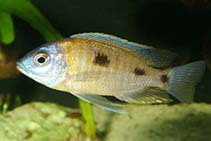| Family: |
Cichlidae (Cichlids), subfamily: Pseudocrenilabrinae |
| Max. size: |
14 cm TL (male/unsexed) |
| Environment: |
benthopelagic; freshwater; pH range: 7.30000019073486 - 8.39999961853027; dH range: 5 - 30; depth range 7 - 19 m |
| Distribution: |
Africa: Endemic to Mbenji Island, Lake Malawi. |
| Diagnosis: |
Dorsal spines (total): 16-18; Dorsal soft rays (total): 10-11; Anal spines: 3-3; Anal soft rays: 8-9. Diagnosis: 3 lateral spots on the body; supra-pectoral spot 2-2.5 times diameter of supra-anal spot; 12-15 gill rakers on the first ceratobranchial; breeding males with yellow breast, wide yellow marginal band in anal fin and a distinct yellow dorsal fin margin (Ref. 57549).
Description: dorsal head profile convex, with a slight concavity between eye and snout tip in large males, convex in females and immatures; gape inclination of mouth about 40° to horizontal; jaws isognathous; teeth in 3 rows on dentary and premaxilla, with outer row teeth bicuspid in females and immatures and unequally bicuspid tending to unicuspid in mature males, while inner rows are unicuspid; lower pharyngeal jaw small, all teeth bicuspid, posterior 2 central teeth sometimes slightly enlarged; gill-rakers on ceratobranchial short and broad-based; 3 rows of teeth in upper and lower jaw; 2-3 scales rows on cheek; 1-3 pored scales posterior to lateral line (Ref. 57549).
Coloration: breeding males: head blue; throat white with gray patches; lateral portion of body light-blue suffused with orange, anterior portion of scales orange/brown and posterior edge of scales light-blue; nape orange/brown; breast yellow with blue/gray spots; belly gray with blue/white highlights; dorsal membranes blue with orange/brown markings, membranes between rays with orange/brown spots and streaks; dorsal spines and rays blue proximally and gray/blue distally; dorsal fin with narrow black submarginal band with white lappets and yellow tips; caudal fin with blue rays and yellow/orange membranes; proximal half of anal fin blue/black, distal half yellow; posterior half of anal fin with white ocelli; pectoral fin clear; pelvic fins yellow/brown with white leading edge and dark band between 1st and 2nd ray (Ref. 57549). Females: head gray/purple; cheeks silvery with purple highlights; opercle silver with brown and purple highlights and black opercular spot; throat white; lateral portion of body with 3 black spots: supra-pectoral spot below 9-lOth scale in contact with upper lateral line and about 2 times size of supra-anal spot; supra-anal spot at 21-23nd scale above and in contact with lower lateral line and covering 2-3 scales; caudal spot same diameter as supra-anal spot on caudal base; above upper lateral line bronze ground color with purple highlights, below upper lateral line silver ground color with center of each scale yellow/brown; 4 vertical bars between supra-pectoral spot and dorsal-fin origin; breast and belly white; dorsal fin clear with orange/brown spots, white lappets, and orange/brown tips; caudal fin gray/yellow with orange/brown spots; proximal 2/3 of anal fin light gray, distal 1/3 clear with orange/brown ocelli and narrow orange/brown edge; pectoral fin clear; pelvic fin clear with gray membrane between first 2 rays (Ref. 57549). |
| Biology: |
Occurs at the sand/rock interface (Ref. 57549). Found at an average depth of 15 m (Ref. 5595). Feeds on plankton (Ref. 5595, 57549) and benthic invertebrates (Ref. 57549). Territorial males build a bowl-shaped bower beneath and/or adjacent to a rock, 18-42cm in diameter and a 4-7 cm high rim; females occur in schools numbering up to 50 individuals, remaining within 2m above the bottom (Ref. 57549). |
| IUCN Red List Status: |
Least Concern (LC); Date assessed: 23 May 2018 Ref. (130435)
|
| Threat to humans: |
harmless |
Source and more info: www.fishbase.org. For personal, classroom, and other internal use only. Not for publication.

